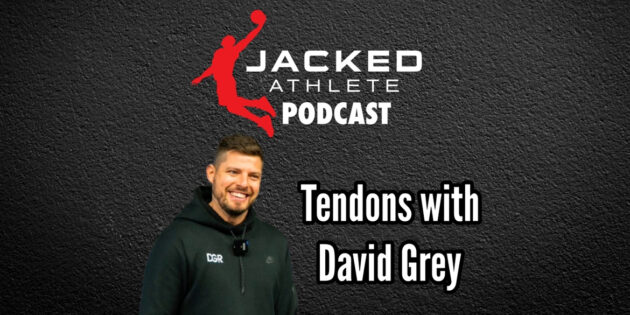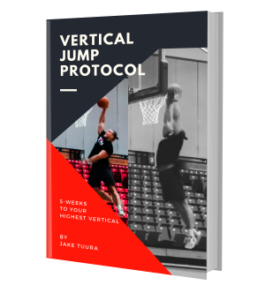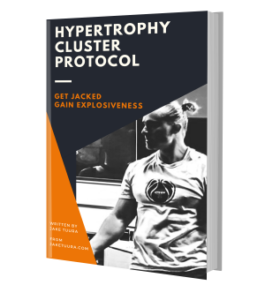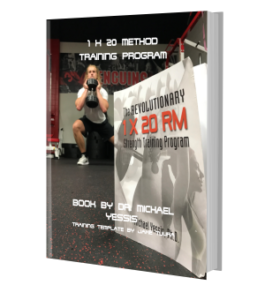https://podcasts.apple.com/us/podcast/jacked-athlete-podcast/id1462537296?i=1000693117364
Knee clicking: “I know everyone says the noise doesn’t really matter, but when it’s sore or when it’s more inflamed, there’s more kind of clicking and cracking in there.”
Patellofemoral Pain and Frequency: “Maybe twice a week loading and then fill up the buckets of all the other stuff that you can do as much as possible. just, especially if it’s a bit angry, one, you do seem to need to let it settle down and stop trying to fix it. Just fucking stop. Just leave it offloaded. And two, it seems to need and like and want much less frequency of loading than the tendon. So that’s kind of where I’m at with that as well. And three, it likes almost completely avoiding loading in full knee extension, just pretend that that first 15 degrees does not exist. Do not go there for a little while.”
Patellofemoral Pain: “Even in our split squats and stuff, leave that last 10 or 15 degrees. I think that there’s a lot of load going through the patellofemoral joint at that stage, but I don’t know if it’s worth the squeeze in terms of how much quad you can get in that top range rather than just kind of staying out of that range and keeping the tension on the quad for longer.”
Doing other non-knee intense loads with Patellofemoral Pain: “as much as you can of everything else, as much as they are willing to do, as much as you can, as many days as you can.”
“There’s nothing worse than, especially for a patellofemoral joint, going into a session where your knee is already a bit sore and a little bit angry and you’re going in and you’re trying to load your quad and it’s like, is this good or is this not? So I’ve seen that that extra day [off] does seem to make a difference.”
“My personal anecdotes for someone that’s had both patellar tendon and Achilles tendinopathy is when I’m training the quad more for my patellar tendon, I am running and jumping a bit better and my knee feels better. When I train my calf more in a good smart way, I’m running and jumping and changing direction better and my Achilles feels better. Like I am more, a little bit more explosive and it feels better because it seems like the muscle is doing more.”
“My Achilles started on my right side, the same side as my patellar tendon. And my patellar tendon was so cooked that I basically was running without bending my knee anymore as far as like, yeah, for all intents and purposes. And I think that my that’s probably what started my tendinopathy journey with my Achilles.”
“I basically stopped giving a lot of my Achilles tendinopathy clients calf raises for a while. And there was a couple of reasons. One, I was just all I was ever given was calf raises and it didn’t, it never really helped me to be honest. And two, I was seeing elite athletes all of the time who had been, had really nasty Achilles tendinopathy for years and were doing calf raises for years and not getting better. So.
we stripped back quite a bit on the calf raises and I started to see a lot of people improve. And what I didn’t realize was actually calf raises are a good exercise, a really good exercise, but most people were overdoing them in terms of frequency and really underdoing them in terms of intensity.”
“There’s a couple of reasons they underdo them with intensity. One is, it can actually be a little bit difficult to load especially in a standing straight knee position. You kind of need a Smith machine to use to really feel like you’re stable and you can push. The second reason practically is that people try to do a full range calf raise and you’re not very strong in your top range of plantar flexion. You’re way weaker in your top range of plantar flexion at the top of a calf raise than you would be in your kind of neutral or dorsiflexed range… We miss that [heavy load] in a calf raise when we try to go for full range, cause you’re so weak at the top.”
“Intensity goes super high when we’re doing our calf work because we load them into the bottom of the range. And I don’t really care if they get a whole lot of past neutral, to be honest. And I make sure they have a nice kind of pause at the bottom.”
“I would definitely be more cautious with giving people the shorter isos with the knee joint than the Achilles… I feel like it’s close to impossible to really, really flare the Achilles up in the gym unless you’re slamming two times body weight, like fast eccentrics on a barbell or something like that. But I feel like a single leg wall sit, a double leg wall sit, could flare someone’s patellar tendon up if they’re just not ready for it. So I think you can, much more likely you can go more aggressive earlier with the Achilles.”
“If I say the words like… Overcoming isometric three seconds on the leg extension. Even from my patellar tendon side… I get like a shiver in my body. I’m like, oh my knee is gonna be sore. But like…
Nah, is my ankle going to be sore when I do an overcoming isometric into a fixed barbell? It’s like, no, it’s not. Unless I do it in a stupid range of motion.”
“So that throws in a massive curve ball in terms of ruptures because how you’re going to make the calves stronger. Like the calves are going to be stronger and you’re going to load them more in a more dorsiflex position. But after a rupture, you’re trying to avoid that dorsiflex position. So now you’re trying to get load into those areas in more plantar flex position where there’s more active insufficiency there and less of the calves are going to be working hard. So this has been a really tricky one for us along the way. I’m so I’m really careful of one, we don’t want to lengthen that tendon too much.”
“Super rigid foot shapes with like a really tucked under heel bone… I think that that is causing more compression on that insertion of Achilles because when they drive their knee forward,
they just have a little bit of less space, I think. they have to, you can actually see a bend through some of these Achilles. It doesn’t go like someone who can kind of open their mid foot. You can see this nicer kind of long line… You can see more of a long line as they go into dorsiflexion.”
“The good thing with rehab is you’re going to push people as hard as you can push people and no harder. And that’s that’s that doesn’t matter if it’s an ACL rehab, if it’s a hamstring rehab, if it’s an Achilles rupture and Achilles tendinopathy. I’m just going to push it as hard as I think I can. And that’s going to constantly change. So if it’s a rupture, if you can do if it’s a partial rupture and you can do single leg calf raises and go nice and heavy, I’m going to go nice and heavy.”
Rupture: “With an Achilles, you’re probably not gonna get any pain to be honest. Yeah, so.
you just judge function. Like you’re looking at range of motion and that doesn’t mean range of more is better. It’s limited range of motion. We want to limit your range of motion and function. Can you do a calf raise? That’s gonna be your big first milestone.”
“One thing I have changed my mind on a bit is the pain during tendinopathy. So for a few years I was kind of very much on the board of like pushing up to a three or four out of 10 pain during a session is fine. Even maybe I was like on the mindset of that’s that’s good. That means we’re working hard. That’s good. As long as it doesn’t spike too much the following day. And I still appreciate that. It’s still fine. But I don’t know. I’m much clearer in my mindset now that I’d much rather it not be sore. I’d much rather find positions where we can just get the load as high as possible without the pain. And I know that sounds incredibly obvious, but I probably wasn’t active enough with trying to do that in the past. I was probably like, because everyone said it’s fine if there’s pain there, I just was like, it’s fine if there’s pain there, rather than being like, it’s fine, but also it’s much better if there’s not.”
Full plantar flexion: “I’ll separate it out. So you will if it’s a rupture again of Achilles, you want to get that top range back because it’s almost impossible for them to get that top range back. They’re just going to be really, really weak there, probably forever or weaker there than they could have been. And I think that’s down to structural changes… And so you do want to make sure that you strengthen that. But you have to separate that out from the foot, the middle range and where you’re going to go for your most load. Because if you’re always trying to choose a weight that loads the top range. It means you’re under loading the bottom range or the middle range So we separate it out. We go right there’s your calf raises and you’re gonna go through whatever range it is if it’s a tendinopathy or a rupture whatever range where you’re allowed to go through go as heavy as you can through this range and then we will do some top range calf raises separately to that if we feel like we need to top it up so in that instance
you’re setting up and you have a plate under your heel and the plate is actually, so you’re starting in plantar flexion, in a decent bit of plantar flexion and you’re just going to go to the top. It’s like a calf raise of like an inch at the top and we’ll just go for super high reps there. So we get a massive burn in that top range or you can load that top range, but we separate it out. It’s two different exercises and that works really well.”
“With lots of parts of the body, with like the back, lower back, the people will encourage movement in all sorts of ways with the hip, they’ll encourage it in all sorts of ways. And then they come to like the ankle and they just do like calf raises and knee to wall. And then they come to the knee and they just do a leg extension.”
“More so with that insertional Achilles I see that a lot where it just tends to be a lot more rigid down there. Now with a regular mid portion tendinopathy, I think it can show up with any with any shape some people have more mobile feet.”
Heel wedges: “Yeah, or a shoe which has a little bit more of a higher heel. Yes, we do. Yep. I think it can help. think it can help with, yeah, certain people who just want to walk better, but mostly we work with athletes and they’re in season and they just are looking for a little bit extra relief. And I think that that is actually super helpful. Just making sure, like, don’t be stretching it during the day. It’s like, you might get short term relief, but stop doing that.”
“If you come in with elbow tendinopathy, I’m probably finding an entry point there where we can load straight away, but I’m most likely going to spend a lot more time looking at how your shoulder and your wrist and stuff moves as well.”
Stiffness with age: “I think it’s a million things because they tend to move with less variety as well. So what you’re kind of describing is a lack of rhythm, a lack of range of motion and a lack of variability. So they don’t move in as many ways. They don’t have as many options. They don’t move through as large a range a lot of the time and they don’t move as smoothly. And partly that is probably to do with a history of injury for a lot of these people. It’s fine if you’re moving around an old knee injury, but now you’re moving around an old knee injury and a hip that feels like crap and a back and blah, blah, blah. So there’s that. There’s a lack of variety in their movement. They just don’t do a lot of different things.”
David’s Website: https://davidgreyrehab.com
David’s Instagram: https://www.instagram.com/davidgreyrehab/?hl=en



